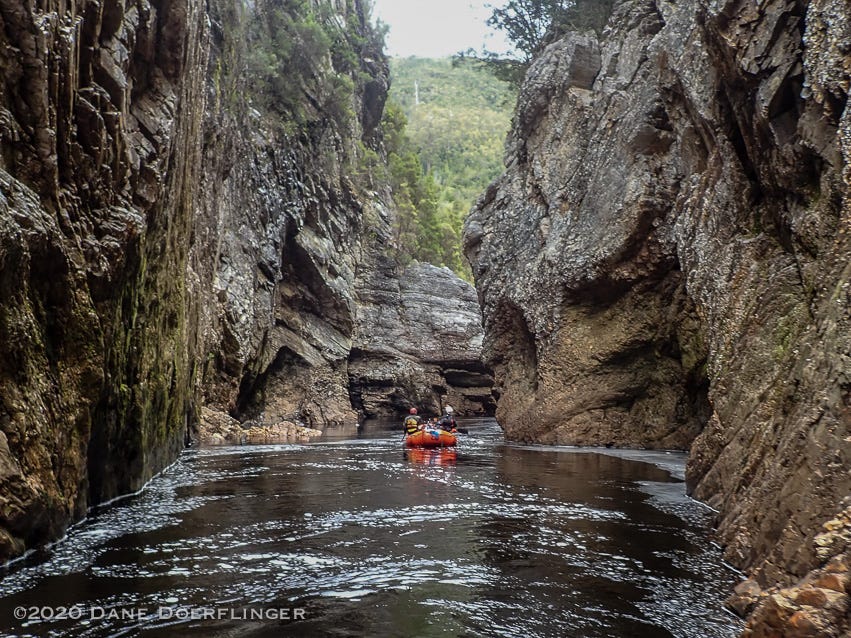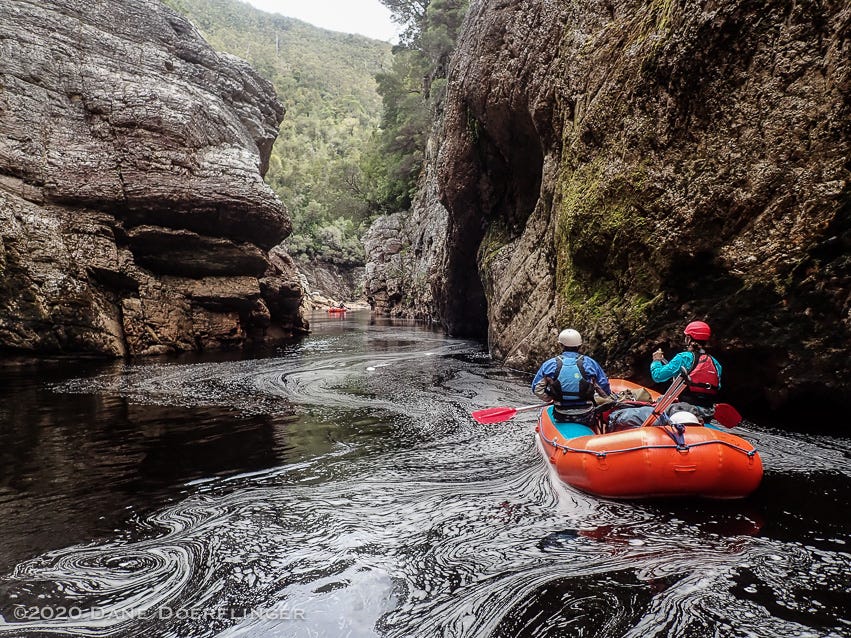
THE EVER VARYING FLOOD
In December of 2017, seven of us ventured Down Under to boat a river only one of us had ever heard of before this trip was planned - the Franklin River. This is our story. It will take several ‘parts’ for me to tell it. I’ll post a ‘part’ - whenever I can - until the story, from my perspective, is complete.
Our trip down the Franklin, and a short, but memorable section of the Gordon, was 129 kilometers long. About 80 miles American. It’s a trip that should, under normal conditions, require a week to eight days. A gnarly, uber-skilled kayaker could manage it in four days. We were advised to allow 11 to 12 days in the event the weather and the river decided to have a high water event as we had seen via the graphs before we had launched.
The Great Ravine is one section of that journey, a very short section actually, but it harbors the most serious whitewater and arduous portages. Within the Great Ravine are four rapids of note: The Churn, The Coruscades, Thunderush and the Cauldron. Each need to be approached with an abundance of caution because a mistake with any of them could be fatal. It’s imperative you reach and portage the third monstrous rapid in the gorge - Thunderush - when the river is not varying high. Because the only portage is along the shore over massive boulders on river left while the water level is on the calmer side. An old high water portage on the right bank, involving humping your gear over land, above the cliffs and through the matted forest had been eliminated by a rock slide.
The entrance to The Great Ravine from the eddy where we landed was hidden from our view even though we were no more than twenty feet above it. The banks were pinched by precipitous swales of rock and there was no level land in sight and, most likely, no level land within easy walking distance.
The ‘track’ we were to utilize to get around our first Great Ravine portage was predictably vertical. ‘Track’ is the Australian euphemism for ‘trail’. The majority of our party had already learned about the nature of Australia’s trail-building techniques a couple of camps back when they sought to reach the renowned Frenchman’s Cap peak on our layover day. Mist, fog and rain thwarted their efforts to make it to the peak but, in the process, they had a new found appreciation for those who would elect to do a weekend trip and then voluntarily hike out of the Franklin Gorge via the Frenchman’s Cap track with their gear on their backs.
It was obvious an evacuation would be a tortuous multi-day affair.
After a quick reconnoiter of The Churn it was ascertained we needed to lift the rafts by rope and pulley up and over a cliff and then lower them into the tumult immediately downstream of the massive rocks creating the thirty foot cascades at the Great Ravine’s entrance. Once hauled to the top of the cliff the rafts were lowered back down the backside of the cliff and stacked three high at the water’s edge. Mind you it was necessary to unburden each raft of our overnight gear and, though we traveled lighter than normal, we still would have to lug a significant amount of ‘stuff’ up, over, around and back down to the boats.
Several hours and one torn drysuit gasket later, the tower of inflatable rafts bucked and pulled in the midst of the angry backwash and aerated outflow. The backeddy was powerful with an equal amount of water pushing you upstream as was flushing downstream. A cliff jutted out below us. In order to paddle around that cliff a few boat-lengths downstream, we would need to buck the current trying to dash us back onto shore. Below the cliff we had to rally for a micro-eddy so as not to accidentally run a drop known as The Corkscrew.
The Corkscrew looked daunting and uninviting yet survivable if push-came-to-paddle. It was also comparatively insignificant to the riot of water we were portaging. A mere micro-eddy separated the boiling backwash of The Churn and the currents cascading between the Volkswagen van-sized boulders of The Corkscrew.
But, to get sucked into it, meant to risk bypassing the one and only camp available to us before the second Great Ravine maelstrom awaiting us a kilometer or so downstream. The day was lengthening and the light in the gorge was failing. We opted to line The Corkscrew and camp that night in declivities masquerading as caves just high enough up the left bank to give you the illusion of safety from a sudden rise in the river level.
As the day serving predominantly as porters was coming to a close, the box wine was brought out to celebrate our one hundred yard incursion into the most anticipated part of our journey. We knew we had - at least - a day and a half left in the ravine.
The next day we would languidly float the deep still waters of Serenity Sound in anticipation of the second ominous rapid in the Great Ravine - The Coruscades. In hindsight, it was as if between each explosion of whitewater and tortured currents in the Great Ravine the exhausted waters of the Franklin would take a respite and wander aimlessly and slowly downstream. The first river explorers must have been hopeful with each stretch of still water, where you could hear the water dripping off the moss, that they had reached their last imposing waterfall. Thus the optimistic naming of the quiet waters below the boisterous waters of The Churn and The Corkscrew - Serenity Sound.
Sadly, their optimism would have been dashed by the lengthy segment of whitewater awaiting them, known as The Coruscades.

###
If you can only afford digital news, or would prefer digital over printed on glossy paper, I highly encourage you to read and support The New Yorker. Were it not for David Remnick and The New Yorker, Ronan Farrow might not have been allowed to tell the story of Harvey Weinstein. It’s a lot to sign up for the weekly magazine, but receiving the digital subscription will give you access to some of the greatest writing online.
Also, here is an extraordinarily adorable dog not named Sally. With some teddy bears. Irresistible.





